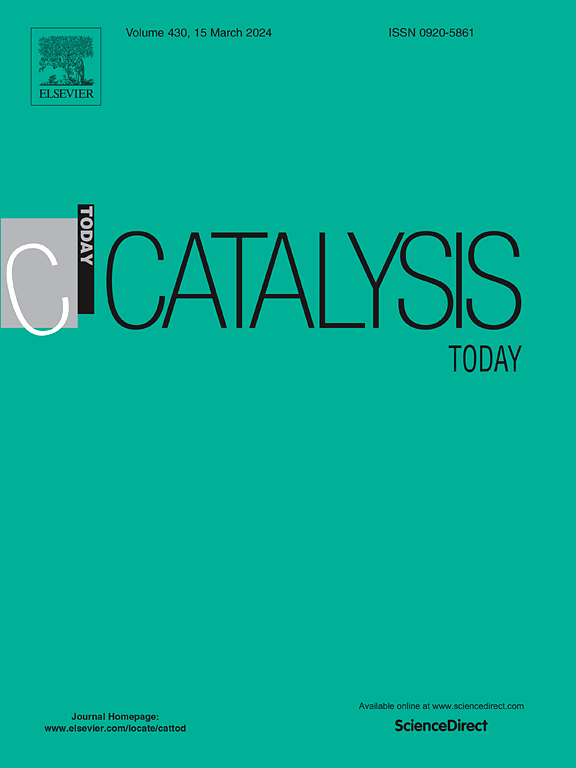Evaluation of the performance and detection of the oxygen reduction reaction kinetics of metal doped imine framework in proton exchange membrane fuel cells
IF 5.2
2区 化学
Q1 CHEMISTRY, APPLIED
引用次数: 0
Abstract
Fe/N/C based catalysts are the best positioned ones to replace the state-of-the-art Pt-based catalysts for the oxygen reduction reaction (ORR) in Proton Exchange Membrane Fuel Cells (PEMFCs). Here, a Fe/N/C catalyst characterized by a high N/C ratio, has been synthesized from the pyrolysis of a N-rich imine-based polymer. In acidic electrolyte (0.1 M HClO4) the catalyst demonstrates notable ORR activity with Eonset and E1/2 values of 1.09 and 0.77 V vs. RHE, respectively. Furthermore, the catalyst’s performance has been assessed in a single cell PEMFC setup. The optimization of the membrane electrode assembly (MEA) with the Fe/N/C catalyst entails examining various ionomer to catalyst ratios (I/C) as well as two coating methods: spray coating and drop casting. The optimized MEA achieved a cell performance of 725 mA cm−2 at 0.3 V and a power density close to 220 mW cm−2. In order to understand the factors influencing PEMFC polarisation curves, electrochemical impedance spectroscopy (EIS) was performed under potentiostatic conditions. The effect of operational parameters, such as ionomer to catalyst ratios (I/C) and the use of either O2 or air at the anode feed, has been investigated. EIS spectra allow the calculation of the distribution of relaxation times (DRT), providing insights into the rate and resistance of the ORR process occurring at the MEA. Notably, the cathode with an I/C= 2, prepared by drop casting, exhibited superior performance attributed to reduced ORR resistances. The current density and power density reached with the 25 cm2 MEA are comparable to those obtained with the 5 cm2 MEA using O2 as cathode reactant.
质子交换膜燃料电池中金属掺杂亚胺骨架的性能评价及氧还原反应动力学检测
Fe/N/C基催化剂是质子交换膜燃料电池(pemfc)中氧还原反应(ORR)的最佳替代催化剂。本文以富N亚胺基聚合物为原料,热解合成了高N/C比的Fe/N/C催化剂。在酸性电解质(0.1 M HClO4)中,催化剂表现出显著的ORR活性,相对于RHE, Eonset和E1/2分别为1.09和0.77 V。此外,在单电池PEMFC设置中评估了催化剂的性能。利用Fe/N/C催化剂对膜电极组件(MEA)进行优化,需要检测不同的离聚物与催化剂的比例(I/C)以及两种涂层方法:喷涂和滴铸。优化后的MEA在0.3 V下的电池性能为725 mA cm−2,功率密度接近220 mW cm−2。为了了解影响PEMFC极化曲线的因素,在恒电位条件下进行了电化学阻抗谱(EIS)分析。研究了操作参数的影响,如离子与催化剂的比例(I/C)和阳极进料时使用O2或空气。EIS光谱允许计算弛豫时间(DRT)的分布,提供对MEA发生的ORR过程的速率和阻力的见解。值得注意的是,通过滴铸法制备的I/C= 2的阴极由于降低了ORR电阻而表现出优异的性能。25 cm2的MEA所达到的电流密度和功率密度与以O2为阴极反应物的5 cm2的MEA所获得的电流密度和功率密度相当。
本文章由计算机程序翻译,如有差异,请以英文原文为准。
求助全文
约1分钟内获得全文
求助全文
来源期刊

Catalysis Today
化学-工程:化工
CiteScore
11.50
自引率
3.80%
发文量
573
审稿时长
2.9 months
期刊介绍:
Catalysis Today focuses on the rapid publication of original invited papers devoted to currently important topics in catalysis and related subjects. The journal only publishes special issues (Proposing a Catalysis Today Special Issue), each of which is supervised by Guest Editors who recruit individual papers and oversee the peer review process. Catalysis Today offers researchers in the field of catalysis in-depth overviews of topical issues.
Both fundamental and applied aspects of catalysis are covered. Subjects such as catalysis of immobilized organometallic and biocatalytic systems are welcome. Subjects related to catalysis such as experimental techniques, adsorption, process technology, synthesis, in situ characterization, computational, theoretical modeling, imaging and others are included if there is a clear relationship to catalysis.
 求助内容:
求助内容: 应助结果提醒方式:
应助结果提醒方式:


